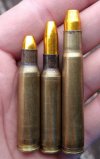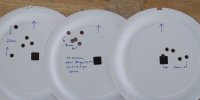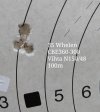Todd; the 9,3x57 should be perfectly balanced for cast bullets! It has always had a following among Swedish hunters, it is also used to some extent in Norway. The good old «potato thrower» (as the Swedes call it) has had something of a come-back in later years. Suppressors are widely used by Scandinavian hunters. When mounting a suppressor, it is tempting to shorten the barrel a bit. The 9,3(and 8mm)x57 are less affected by shortening the barrel than some other cartridges, typically loaded with slower powders.
CW; time to break out that Whelen, and heat it up! It deserves it!
Shot some copper plated 180grs H&N truncated cone bullets today. It is the cartridge on the right, below. The other cartridges are .308win, also with copper plated bullets. A 71 grs «32acp»- bullet, and a 165grs FN. H&N claim to have a plastic coating over the copper, to eliminate copper fouling.

I did a little load testing last trip, and 23 grs Vihta N110 seemed to give very good accuracy, and relevant point of impact with the 180grs bullet. Load development was done with quite fresh (for me) S&B cases, and CCI LRP primers. Today, I had (for various reasons) loaded in some well-used R-P cases with win LRP primers.
First, I shot 25 rounds of powder coated bullets. I was curious how the barrel would react to a change in projectile.
Then I fired one copper plated bullet into water containers to check for expansion (the copper layer is really thin!). Clean pass-through, no expansion.
Then the first 5-shot group @ 100m. High, left; a little over 2 MOA. Disappointing. Surprising as well, the POI should be closer to POA. Could the change in brass and primer have so much effect?
Second 5-shot group- significant contraction to near 1 MOA. POI still high-left.
Third 5-shot group, wind flags going crazy (as you can see in the target). POI wanders to anticipated place.
It seems to be a bit of bore conditioning going on, when switching from PC to copper plated. Last time, when i switched the other way, I had splendid accuracy with PC right away.
Side note: the .308 165grs FN bullet shoots consistent 5-shot 1MOA groups at 100m. These copper plated bullets are fun!





